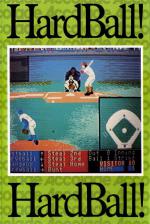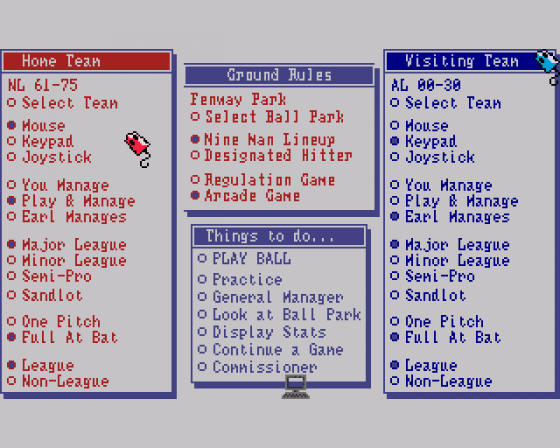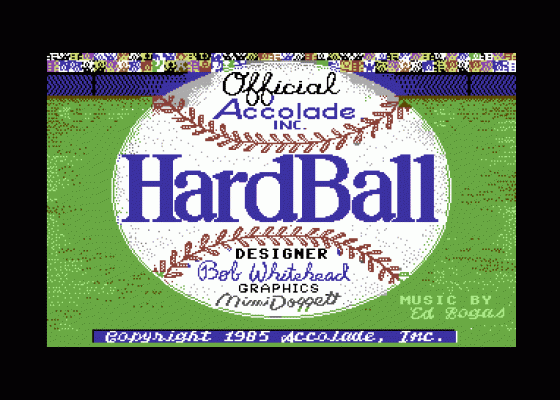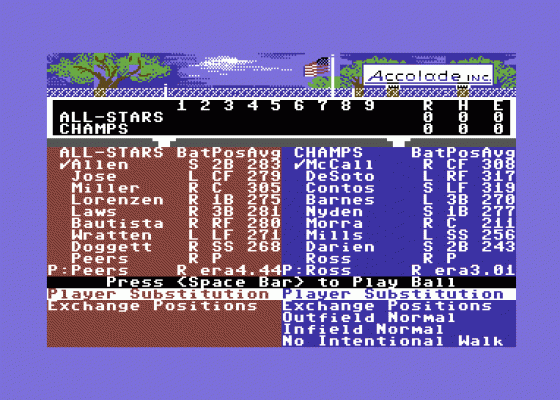
Commodore User
 1st October 1987
1st October 1987
Categories: Review: Software
Author: Francis Jago
Publisher: Accolade
Machine: Commodore 64
Published in Commodore User #49
Hard Ball Vs. Earl Weaver
With the notable exception of American Football, few sports originated in the US have ever really taken off in a big way over here in good old Blighty. Basketball may get a few minutes on Channel 4, but then so does everything from tortoise racing to hedgehog splatting! The only sport that might possibly become as popular as American Football with the British is baseball.
With the back-up of complete coverage of this year's World Series (the equivalent of the F.A. Cup of Baseball) on Channel 4, together with the roll-over hype from the Super Bowl, it seems likely that we will be seeing much more of this bat 'n ball game.
For this reason, the launch of two new baseball games for the Amiga should be of great interest for those gamesters who feel this cross between rounders and cricket is for them.

Although technically a comparison, it took only a few minutes for it to become clear that, apart from sharing baseball as the common denominator, HardBall and Earl Weaver are completely different and therefore not comparable.
Until recently I thought baseball was a pretty boring game. It seemed to be little more than a glorified version of rounds except that it is played by men wearing silly suits. About two months ago, however, I was forced - against my will I can assure you - to go to Hyde Park and take part in a 'friendly' game of baseball.
As I woke up the next morning bruised, battered and generally feeling pretty awful, I realised that perhaps baseball is not so weedy. It is this side of baseball that HardBall concentrates on. Much more of an arcade game that a simulation, it takes the exciting sections of a game and compacts it into a few nail-biting seconds.

Having played the 64 version, I took the easy route into the game and started playing immediately. Wow! The graphics and animation were always good, but on the Amiga they are incredible. In play there are three separate screens, two action, and one for managerial type decisions.
The first of the action screen shows a view from behind the pitcher showing the pitcher on his mound, the batter (that's what they're called) and the catcher. The decisions open to you depend mainly on whether your side is batting or fielding.
If you are batting, then you must try and anticipate the pitch you will receive, and then time your swing perfectly. In play, this turned out to be difficult, but by no means impossible, and soon I was keeping up with the computer, and even smashing the odd homer. When pitching, you must decide both what type of pitch (slider, fastball, curve, off speed or change-up), and where to pitch up. Too many clever pitches and the batsman will get a free walk to first base, too few and you'll be hit all over the ground. After a few innings, it is possible to spot the good and bad batters, and take action accordingly.

If either you, or the opposition, manage to hit a ball, then the screen flicks to hit a ball, then the screen flicks to a new display that shows the whole diamond (playing area). As the ball whizzes along, you either watch or control little men who scurry around the field trying to catch or field it. If you are fielding, you must attempt either to catch the ball, or to field it as quickly as possible and throw it to a base towards which one of the opposition is sprinting, and if you are batting, you must get to base prior to the ball.
Throughout the game, HardBall feels like an arcade game that has had strategy added for effect. Dedicated baseball fans will be able to use the managerial screens to good effect - substituting players and swapping field positions about, but I have to confess that, for me, my ignorance of all the technicalities of this particular game only added to my enjoyment.
As well as excellent graphics, HardBall has some interesting sound effects. The game starts with a painful loading screen that makes the likes of Spagna sound musical, and carries on in this vein with some very odd sampled sounds (most of which sound like people being tortured!).
Electronic Arts' baseball game is a different catcher's mitt altogether. As with many of their games, they rely on having a famous sporting hero as the ghosted author to add to the sales potential of the game - although I for one have never heard of Earl Weaver.
Going from HardBall to this you really would not believe it was the same game. Earl Weaver baseball is slow, complicated and requires a great deal of practice. But in the end it can be very rewarding.
Apart from giving comprehensive instructions, the manual gives a potted life history of Earl; he was a third grade baseball player who became a quite successful manager. He was not, as the manual would have you believe, a god!
After a few hours studying the instructions it becomes very apparent that this game is a great deal more complicated that it at first seems, and the explains why it took me three innings to realise that I had been playing against a non-existent player!
As well as selecting your team, and positioning them on the diamond, you can design a ball park, check the pitcher's speed, replay any play in slow motion, and ask Earl Weaver's advice on any play. To describe this game as comprehensive would be an understatement. Added to these special effects are most of the features of HardBall, together with important improvements, such as the ability to restart if you are going for a base (something I found useful on more than one occasion!).
The graphics on this game are not as good as those in HardBall; the men are not as well illustrated, and the animation is, although very smooth, not quite as well executed. The sound, however, is noticeably better. Sampled throughout, the game makes good use of the Amiga's speech facilities, as well as some excellently sampled phrases; such as "Yoooou're out!!!" if you fail to make a base of "Strrikkeee!!" should you fail to hit one of the demon computer pitches.
Although both these games are very different in their approaches to computerising baseball, they do share a certain amount of basic features. Both of these games are one or two player and, to be honest, both are pretty meaningless unless you have, or wish to have, some knowledge of baseball. Fans of sports simulations will find there is a great deal within both games, although strategies will certainly find Earl Weaver more to their liking.
Both games use the Amiga's features well, it is only a pitch that they could not combine HardBall's graphics with Earl Weaver's sound, then you really would have had a great fame! As with most good Amiga games, both of these are priced at just under £25, much too much, but it seems to be the figure on which everyone has agreed.
As I said at the beginning, these two games really are not comparable, but, after a week, it was Earl Weaver that I returned to. HardBall is instantly appealing, but in the long term, Earl Weaver's added features make the game more stimulating.
Other Reviews Of HardBall For The Commodore 64
Hardball (US Gold/Accolade)
A review
American Pie
Yankee sport, it's brill ain't it? All those burgers, hot dogs, barbecues in the car park, massively overweight gridiron geezers and cheeky cheerleaders. No wonder Phil "The Industrial Freezer" King volunteered to go Stateside and check out a Superbowl full of glitzy sport sims...
Hardball (US Gold/Accolade)
A review
Hardball (Accolade)
A review
Hardball (US Gold/Accolade)
A review by Chris Anderson (Commodore User)










